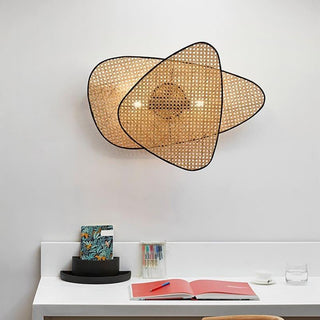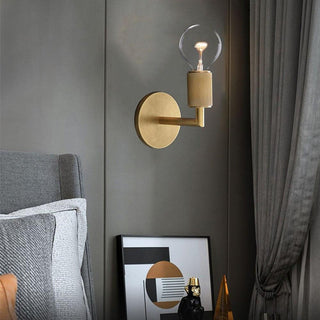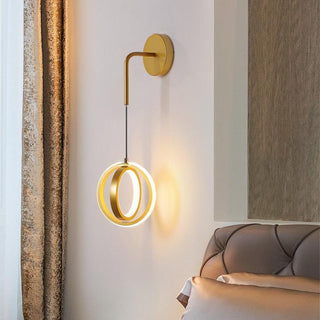Wall sconces are an elegant and versatile way to add light, style, and ambiance to any room. Whether you're looking to create a cozy reading nook, brighten up a bathroom mirror, or add warmth to an outdoor entryway, proper wall sconce placement is essential. A well-placed sconce enhances both functionality and aesthetics, creating a welcoming and visually appealing environment. This guide will help you understand the ideal height, spacing, and placement for wall sconces in various spaces, along with tips to avoid common mistakes.
1. Why wall sconce placement matters
Wall sconces do more than add light; they shape the ambiance, accentuate decor, and enhance functionality. Correct placement of wall sconces brings out the best in your room’s design, offering targeted lighting where you need it most.
For instance, in a hallway, properly spaced sconces provide a warm, welcoming glow that lights up the path without overwhelming the space. In contrast, a poorly placed sconce can cause glare or cast awkward shadows, disrupting the room's balance.
Whether you’re aiming for functional lighting around a mirror or accent lighting for artwork, the right sconce height and spacing are essential for achieving the ideal look.
2. General guidelines for wall sconce height and spacing

2.1. Optimal height for wall sconces
The ideal height for wall sconces typically ranges from 60 -72 inches from the floor to the center of the fixture. This height generally positions the light at eye level, providing comfortable and effective lighting for most people.
In spaces with ceilings lower than 9 feet, you may want to install sconces a bit lower, aiming for no more than 60-65 inches from the floor, to maintain a sense of proportion.
2.2. Rule of thumb for spacing
When spacing sconces along a wall, aim to place them about 6 to 8 feet apart. This spacing provides a balanced distribution of light, avoiding both overly bright spots and dark gaps. In smaller spaces like narrow hallways, keep the spacing closer to 6 feet for a seamless flow of light.
When sconces frame a central piece—such as a bed, vanity, or sofa—symmetrical spacing is key. Position each sconce equidistant from the item to create a visually balanced look, avoiding the discomfort of uneven lighting.
For example, place wall lamps on either side of a bathroom mirror at equal distances to achieve even bathroom lighting. Likewise, when accenting a sofa or bed, mount sconces at the same height and distance on both sides to create a cohesive, beautiful effect that complements the decor. This symmetrical approach ensures that mounted lights enhance the space’s style, especially in modern interiors, and provide optimal illumination for both functionality and ambiance.
Factors affecting wall sconce height and placement
Several factors can influence the ideal height and placement of your wall sconces. The height of your ceiling, the intended purpose of the light, and the specific design of the room all play a role.
For example, higher ceilings may benefit from sconces placed a little higher than the standard height. Additionally, if the sconce is intended for reading or task lighting, as with a bedside sconce, adjusting the height to direct light exactly where it's needed can make the fixture more functional.
3. Room-by-room wall sconce placement guide
Each room in the house has unique lighting needs, and the placement of wall sconces should reflect that. Here’s how to approach sconce placement in different areas.
3.1. Bedroom wall sconces

In the bedroom, wall sconces are often used as bedside lamps. Here are a few rules of thumb to determine the perfect bedside wall sconce placement:
- Place them about 30 to 36 inches above the top of the mattress, for optimal reading height and a cozy ambiance (since standard bed height is around 25 inches, that makes it approximately 55 to 60 inches from the floor)
- Allow 6 to 18 inches of horizontal space between the sconce and the headboard for comfortable positioning.
- If the sconce has a built-in switch, ensure it’s within easy reach while seated in bed.
- Center the nightstands under the sconces for a balanced look if you have nightstands.
- We recommend avoiding adding extra bedside lamps, as they can make the space feel cluttered—let the wall sconces create a clean, open look.
For a reading nook, a sconce with a swing arm beside a chair at shoulder height provides focused light without taking up space. Adjustable sconces work well for this purpose, allowing you to bring the light closer when you need it and keep it subtle otherwise.
3.2. Bathroom Wall Sconces
Lighting around the mirror

Bathroom wall sconces are highly effective when placed on each side of the mirror to create even, task-focused lighting.
- For optimal results, hang sconces at eye level, around 60 to 72 inches from the floor, so that light shines directly across the face. This height reduces shadows, making it easier to apply makeup, shave, or complete other grooming tasks with accuracy.
- Spacing the sconces approximately 3 feet apart provides balanced lighting. This placement allows each sconce to act as a direct source of light that minimizes shadows and enhances visibility.
Lighting above the mirror

If you prefer a single fixture above the mirror, a long vanity light bar or bathroom light bar is a stylish and functional choice. This type of overhead lighting fixture distributes light evenly across the entire mirror surface, making it ideal for smaller mirrors or bathrooms where wall space is limited.
- Align the light bar with the center of the mirror.
- For best results, choose a light bar that spans about three-quarters of the mirror's width to ensure full coverage and eliminate dark spots. For example, if your mirror is 24 inches wide, select a vanity light that is around 18 inches wide.
- Position the light bar approximately 75 to 80 inches above the floor for optimal illumination.
Sconce placement for bathrooms with double sinks
In bathrooms with double sinks, you can either install one sconce on each side of each mirror for a balanced, symmetrical look or mount a single long fixture above each mirror to provide full, even coverage. LED lighting options in warm white are excellent choices here, as they offer bright yet ambient lighting that’s ideal for daily routines.
Tip for bathroom lighting: consider light fixtures with dimmable light bulbs for added flexibility, allowing you to adjust the light’s brightness according to the time of day and desired ambiance. Frosted glass or matte finishes on the fixtures enhance the look by adding decorative touches that soften the light, making it both functional and beautiful.
3.3. Living room wall sconces
Living rooms often use wall sconces for ambient or accent lighting. The ideal height for living room sconces is around 60 to 72 inches from the floor. If you’re highlighting artwork, make sure the light shines directly on the piece without creating glare.
When hanging sconces near a picture or mirror, position them about 4 to 6 inches away from the edges of the frame. This spacing avoids harsh shadows and ensures that the light highlights the artwork without overpowering it. Brass or vintage-style sconces flanking a large mirror above a sofa or console table add a sophisticated and warm touch to the room.
3.4. Kitchen wall sconces
In the kitchen, wall sconces provide both functional and decorative lighting. They are often placed above countertops or alongside open shelving to create focused task lighting. When installing sconces above a countertop or sink area, mount them at a height that’s high enough to avoid interference with cabinetry but low enough to offer sufficient light. For these applications, sconces mounted around 60 to 70 inches from the floor are generally effective.
For example, adding vintage-style sconces above a kitchen window or sink can create a cozy, inviting feel during evening meal prep, while ensuring that the light is exactly where you need it.
3.5. Exterior wall sconces
For outdoor lighting, such as around entryways or along pathways, you can follow the general rule given above of 60-72 inches from the ground or porch floor. This height ensures that the light illuminates the path without shining directly into people’s eyes. Don't hesitate to adjust it if the standard rule doesn't feel right, as the ideal height can depend on other factors unique to your house.
When placing sconces on either side of an entry door, aim to space them about 5 to 6 feet apart to create a balanced, welcoming appearance.
LED exterior sconces are a popular option, as they provide efficient lighting while enhancing curb appeal. A pair of outdoor sconces flanking the entrance door creates a warm welcome, while additional fixtures along a walkway add both safety and style.
Conclusion
Choosing the right height and spacing for wall sconces can significantly impact the overall ambiance, functionality, and aesthetic appeal of a room. Whether you're aiming for task lighting, accent lighting, or ambient light, following these guidelines will help you make the most of your space. Adjust placements according to ceiling height, room function, and personal style to create a beautifully lit, welcoming environment in any room of your home. Enjoy the process of enhancing your spaces with the perfect wall sconces, and watch how a small lighting change can transform the feel of an entire room!
Frequently asked questions about wall sconce placement
What is the standard wall sconce height?
The standard height for wall sconces is generally 60-72 inches from the floor to the center of the fixture, allowing for eye-level lighting in most spaces. Adjustments may be necessary based on ceiling height and the specific needs of the room.
How far from the mirror should bathroom sconces be?
To achieve even lighting in the bathroom, place sconces on either side of the mirror at eye level, roughly 65-70 inches from the floor, and space them about 3 feet apart.
What height should a wall sconce be next to a bed?
For bedside sconces, a height of 48-60 inches from the floor, or 12-24 inches above the bed frame, provides optimal lighting for reading or other bedside activities.
How far apart should wall sconces be?
Spacing sconces 6-8 feet apart along a wall generally provides balanced illumination. In narrower spaces like hallways, aim for around 6 feet between sconces.
How do you position sconces next to a picture in the living room?
When framing a picture or mirror, place sconces about 4-6 inches from the edges of the frame to avoid shadows and ensure even lighting on the artwork or mirror.



